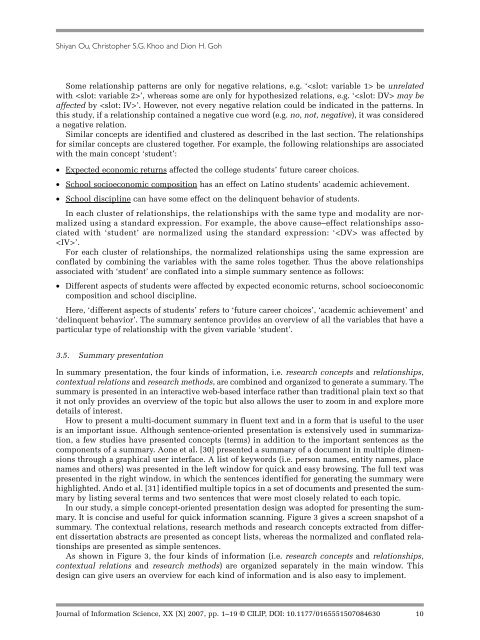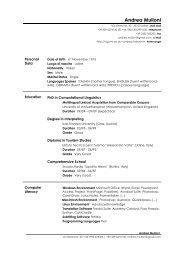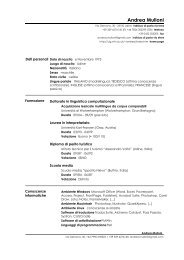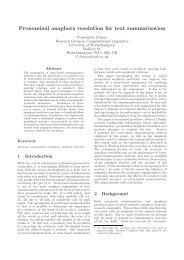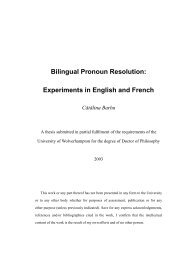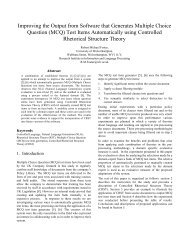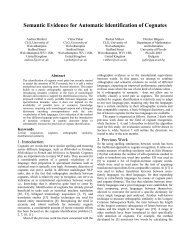Design and development of a concept-based multi ... - Citeseer
Design and development of a concept-based multi ... - Citeseer
Design and development of a concept-based multi ... - Citeseer
You also want an ePaper? Increase the reach of your titles
YUMPU automatically turns print PDFs into web optimized ePapers that Google loves.
Shiyan Ou, Christopher S.G. Khoo <strong>and</strong> Dion H. Goh<br />
Some relationship patterns are only for negative relations, e.g. ‘ be unrelated<br />
with ’, whereas some are only for hypothesized relations, e.g. ‘ may be<br />
affected by ’. However, not every negative relation could be indicated in the patterns. In<br />
this study, if a relationship contained a negative cue word (e.g. no, not, negative), it was considered<br />
a negative relation.<br />
Similar <strong>concept</strong>s are identified <strong>and</strong> clustered as described in the last section. The relationships<br />
for similar <strong>concept</strong>s are clustered together. For example, the following relationships are associated<br />
with the main <strong>concept</strong> ‘student’:<br />
• Expected economic returns affected the college students’ future career choices.<br />
• School socioeconomic composition has an effect on Latino students’ academic achievement.<br />
• School discipline can have some effect on the delinquent behavior <strong>of</strong> students.<br />
In each cluster <strong>of</strong> relationships, the relationships with the same type <strong>and</strong> modality are normalized<br />
using a st<strong>and</strong>ard expression. For example, the above cause–effect relationships associated<br />
with ‘student’ are normalized using the st<strong>and</strong>ard expression: ‘ was affected by<br />
’.<br />
For each cluster <strong>of</strong> relationships, the normalized relationships using the same expression are<br />
conflated by combining the variables with the same roles together. Thus the above relationships<br />
associated with ‘student’ are conflated into a simple summary sentence as follows:<br />
• Different aspects <strong>of</strong> students were affected by expected economic returns, school socioeconomic<br />
composition <strong>and</strong> school discipline.<br />
Here, ‘different aspects <strong>of</strong> students’ refers to ‘future career choices’, ‘academic achievement’ <strong>and</strong><br />
‘delinquent behavior’. The summary sentence provides an overview <strong>of</strong> all the variables that have a<br />
particular type <strong>of</strong> relationship with the given variable ‘student’.<br />
3.5. Summary presentation<br />
In summary presentation, the four kinds <strong>of</strong> information, i.e. research <strong>concept</strong>s <strong>and</strong> relationships,<br />
contextual relations <strong>and</strong> research methods, are combined <strong>and</strong> organized to generate a summary. The<br />
summary is presented in an interactive web-<strong>based</strong> interface rather than traditional plain text so that<br />
it not only provides an overview <strong>of</strong> the topic but also allows the user to zoom in <strong>and</strong> explore more<br />
details <strong>of</strong> interest.<br />
How to present a <strong>multi</strong>-document summary in fluent text <strong>and</strong> in a form that is useful to the user<br />
is an important issue. Although sentence-oriented presentation is extensively used in summarization,<br />
a few studies have presented <strong>concept</strong>s (terms) in addition to the important sentences as the<br />
components <strong>of</strong> a summary. Aone et al. [30] presented a summary <strong>of</strong> a document in <strong>multi</strong>ple dimensions<br />
through a graphical user interface. A list <strong>of</strong> keywords (i.e. person names, entity names, place<br />
names <strong>and</strong> others) was presented in the left window for quick <strong>and</strong> easy browsing. The full text was<br />
presented in the right window, in which the sentences identified for generating the summary were<br />
highlighted. Ando et al. [31] identified <strong>multi</strong>ple topics in a set <strong>of</strong> documents <strong>and</strong> presented the summary<br />
by listing several terms <strong>and</strong> two sentences that were most closely related to each topic.<br />
In our study, a simple <strong>concept</strong>-oriented presentation design was adopted for presenting the summary.<br />
It is concise <strong>and</strong> useful for quick information scanning. Figure 3 gives a screen snapshot <strong>of</strong> a<br />
summary. The contextual relations, research methods <strong>and</strong> research <strong>concept</strong>s extracted from different<br />
dissertation abstracts are presented as <strong>concept</strong> lists, whereas the normalized <strong>and</strong> conflated relationships<br />
are presented as simple sentences.<br />
As shown in Figure 3, the four kinds <strong>of</strong> information (i.e. research <strong>concept</strong>s <strong>and</strong> relationships,<br />
contextual relations <strong>and</strong> research methods) are organized separately in the main window. This<br />
design can give users an overview for each kind <strong>of</strong> information <strong>and</strong> is also easy to implement.<br />
Journal <strong>of</strong> Information Science, XX (X) 2007, pp. 1–19 © CILIP, DOI: 10.1177/0165551507084630 10


